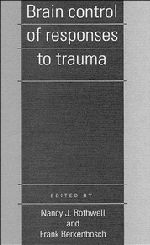Book contents
- Frontmatter
- Contents
- Contributors
- 1 Introduction
- 2 Responses to injury
- 3 Experimental approaches to the central nervous system control of responses to trauma
- 4 Neurohormonal control of cytokines during injury
- 5 Brain regions involved in modulation of immune responses
- 6 Psychological and neurobiological consequences of trauma
- 7 Central nervous system control of sickness behavior
- 8 Psychological and behavioural aspects of pain
- 9 Central control of cardiovascular responses to injury
- 10 Neuroendocrine responses to physical trauma
- 11 Central control of metabolic and thermoregulatory responses to injury
- 12 Central control of pain
- 13 The final word …
- Index
5 - Brain regions involved in modulation of immune responses
Published online by Cambridge University Press: 05 August 2016
- Frontmatter
- Contents
- Contributors
- 1 Introduction
- 2 Responses to injury
- 3 Experimental approaches to the central nervous system control of responses to trauma
- 4 Neurohormonal control of cytokines during injury
- 5 Brain regions involved in modulation of immune responses
- 6 Psychological and neurobiological consequences of trauma
- 7 Central nervous system control of sickness behavior
- 8 Psychological and behavioural aspects of pain
- 9 Central control of cardiovascular responses to injury
- 10 Neuroendocrine responses to physical trauma
- 11 Central control of metabolic and thermoregulatory responses to injury
- 12 Central control of pain
- 13 The final word …
- Index
Summary
From the experimental and clinical evidence of brain-immune relationships (Blalock, 1989; O'Leary, 1990; Khansari et al, 1990) two main questions arise: what are the central nervous structures involved in neuroimmunomodulation? and how do the brain and the immune system communicate?
In order to answer the first question, the most useful approach is to study the immune effects of lesioning different areas of the central nervous system. Even though this approach contains some inbuilt methodological problems related to the plasticity of the immune and central nervous systems, the data now available permit us to answer this question, at least partly, and also suggest the existence of functional brain networks in neuroimmunomodulation.
Effects of brain lesions on immune reactivity
Hypothalamic and brainstem lesions
Bilateral lesions of the hypothalamus have been consistently shown to induce changes in immunity. Early works showed that local lesions of the hypothalamus protected guinea pigs (Filipp & Szentivanyi, 1958; Szentivanyi & Filipp, 1958) and rats (Luparello et al, 1964) from lethal anaphylactic shock. Moreover, these protective effects of hypothalamic lesions were not necessarily associated with lower titres of antibodies as measured by passive cutaneous anaphylaxis (Stein et al, 1976). Later, it was demonstrated that rats showed profound alterations in the architecture of lymphoid organs 32 days after electrolytic lesions of the hypothalamus. In the thymus, there was a profound depletion of lymphocytes, a reduction of the cortex and a disappearance of the corticomedullary junction. In spleen and lymph nodes, there was a decrease in the number of lymphocytes and plasma cells, as well as an absence of germinal centres (Isakovic & Jankovic, 1973). The same electrolytic lesions, performed 24 h before immunization against bovine serum albumin, lowered serum antibody levels and reduced the intensity of Arthus and delayed hypersensitivity reactions as late as 30 days after the first antigen challenge (Jankovic & Isakovic, 1973). More recently, Keller et al. (1980) reported that, in guinea pigs, electrolytic lesions of the anterior hypothalamic area suppressed delayed hypersensitivity to tuberculin. These lesions also depressed mitogenesis induced by phytohaemagglutinin (PHA) when using whole blood but not when using purified lymphocytes. Similarly, the depression of spleen lymphocyte mitogenesis observed after electrolytic lesions of preoptic and anterior areas has been reversed by removing macrophages from spleen cells (Roszman et al, 1982).
- Type
- Chapter
- Information
- Brain Control of Responses to Trauma , pp. 108 - 122Publisher: Cambridge University PressPrint publication year: 1994



